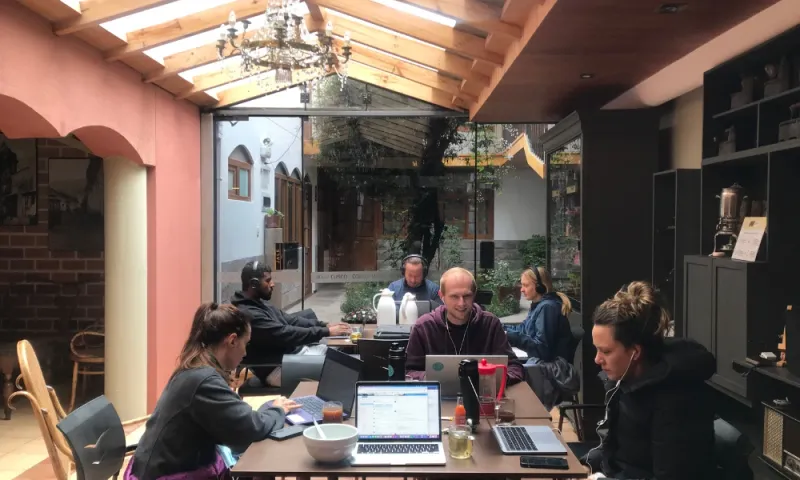Picture this: working from a café in Thailand one month, then setting up your laptop in a cozy apartment in Portugal the next. Digital nomad life sounds like the ultimate dream, right? But behind those Instagram-perfect photos of laptops on tropical beaches lies a more complex reality. Let’s explore what this growing lifestyle is really about and whether it lives up to the hype.
1. The Digital Nomad Army Keeps Growing

Over 35 million people worldwide now call themselves digital nomads, and that number jumps higher every year. The pandemic changed everything, showing companies that remote work actually works pretty well.
Suddenly, people realized they could keep their jobs while exploring the world. This isn’t just a trendy phase anymore. Major surveys show this lifestyle is becoming a permanent part of how we think about work and life balance.
Young professionals especially love this freedom, turning what used to be a retirement dream into an everyday reality.
2. Cities Beat Beaches for Most Nomads

Forget those dreamy beach photos you see everywhere. Most digital nomads actually prefer bustling cities over sandy shores when it comes to getting work done.
Places like Chiang Mai in Thailand, Lisbon in Portugal, and Mexico City top the popularity lists. Why? These spots offer reliable internet, affordable living costs, and plenty of coworking spaces where you can actually focus.
Beach towns might look amazing on social media, but try answering important client calls with waves crashing in the background. Cities provide the infrastructure nomads need to succeed professionally.
3. Wi-Fi Quality Makes or Breaks Everything

Strong internet connection isn’t just nice to have for digital nomads – it’s absolutely essential for survival. One bad Wi-Fi day can mean missed meetings, angry clients, and lost income.
Smart nomads research internet speeds before booking any accommodation. They carry backup plans like portable hotspots and know which cafes have the most reliable connections in each city they visit.
Some destinations still struggle with consistent internet service, making careful planning crucial. Nothing kills the nomad dream faster than trying to upload important files on a connection slower than dial-up.
4. Countries Roll Out Welcome Mats with Special Visas

Governments worldwide are catching onto the digital nomad trend, and they want a piece of the action. Over 40 countries now offer special visas designed specifically for remote workers.
Spain, Croatia, Costa Rica, and Portugal lead the pack with nomad-friendly visa programs. These permits let you stay much longer than typical tourist visas allow, sometimes up to a year or more.
Before these programs existed, nomads had to do visa runs every few months, constantly moving to stay legal. Now you can settle in and really experience a place without worrying about overstaying your welcome.
5. Your Dollar Stretches Much Further Abroad

One of the biggest draws of nomad life is making your money go way further than it would back home. Living in Southeast Asia or parts of Latin America can cost less than half of what you’d spend in New York or London.
Imagine paying $500 for a nice apartment in Mexico instead of $3000 in San Francisco, while still enjoying great weather, good food, and fast internet.
This cost difference means nomads can save money while living better than they could afford in expensive home cities. It’s like getting a raise just by changing your zip code.
6. Building Community Fights the Loneliness

Working alone in foreign countries sounds isolating, but most nomads actively build social networks wherever they go. Coworking spaces serve as instant community hubs where you can meet like-minded people.
Co-living arrangements are becoming super popular too, offering built-in roommates who understand the nomad lifestyle. Local meetups, networking events, and online communities help newcomers connect quickly.
The nomad community is surprisingly supportive and welcoming. People share apartment tips, recommend reliable cafes, and even help each other through visa complications. Loneliness is definitely a challenge, but it’s not inevitable with effort.
7. Work-Life Balance Gets Complicated

Here’s the reality check nobody talks about: many nomads end up working more hours than they did in traditional office jobs. When your office is also your vacation spot, boundaries get really blurry.
Time zones create havoc with client calls and deadlines. You might find yourself taking meetings at 2 AM or working weekends to match your home country’s schedule.
The pressure to make the lifestyle work financially often leads to overcommitting to projects. That dream of working a few hours then exploring all day? Most nomads admit it rarely happens that way in practice.
8. Corporate Employees Join the Movement

Digital nomadism used to be exclusively for freelancers and entrepreneurs who could control their own schedules. Not anymore – regular employees are getting in on the action too.
Tech companies, marketing agencies, and startups now encourage or at least allow employees to work nomadically. Some businesses even offer nomad stipends or organize company retreats in nomad-friendly destinations.
This shift means nomads now include software developers, marketing managers, customer service reps, and consultants with steady paychecks. The lifestyle isn’t just for risk-taking freelancers anymore – it’s becoming a mainstream work arrangement.
9. Real Challenges Nobody Warns You About

Behind the glossy social media posts, nomad life comes with serious headaches that can catch newcomers off guard. Visa bureaucracy creates constant stress, with paperwork and requirements changing without notice.
Healthcare access becomes complicated when you’re always moving between countries with different medical systems. Getting sick abroad is expensive and scary without proper insurance coverage.
Burnout from constantly adapting to new places, currencies, and cultures is more common than people admit. Some nomads eventually crave stability and routine after months of perpetual change and decision-making fatigue.
10. It’s Work First, Vacation Second

The biggest myth about digital nomad life? That it’s one endless vacation with occasional work breaks. Reality check: most nomads work full-time jobs just like everyone else.
The difference is location flexibility, not work flexibility. You still have deadlines, meetings, and responsibilities – they just happen with better views and different time zones.
Successful nomads treat their work seriously and maintain professional standards regardless of whether they’re in Bangkok or Berlin. The lifestyle works because it combines career advancement with travel opportunities, not because it replaces work with permanent vacation mode.



